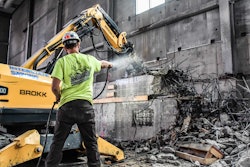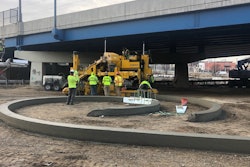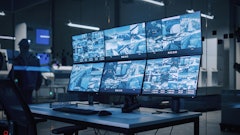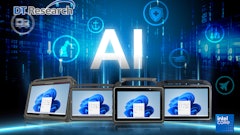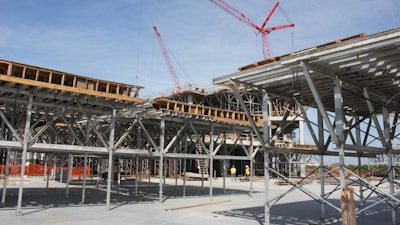
Orlando, Florida-based Universal Forming, Inc. (UFI) offers a wealth of services ranging from preconstruction to formwork to complete concrete structures. While the formwork facet of the job has long relied upon total station technology, the company recently upped its game with the addition of a robotic solution.
The decision fits perfectly into Bill Nagele’s penchant for getting better results while minimizing manpower-intensive efforts and reducing the risk of error. That’s a key reason his company relied heavily on a Topcon robotic total station on the recent $400 million expansion of the Moffitt Cancer Research Center in Tampa.
Focus on Productivity
UFI was formed in 2005 when Nagele and Todd Volheim decided to combine their 40 years of successful concrete construction experience and establish a company that could expertly build and provide construction management of large, complex concrete structures. Today, the company employs more than 400 people, has weathered downturns that others couldn’t and has established itself as one of the leading concrete structure builders in the state of Florida – thanks to an unflagging commitment to excellence in quality, safety and adherence to schedules.
 Getting better results while minimizing manpower was a key reason UFI used a Topcon robotic total station on the $400 million expansion of the Moffitt Cancer Research Center.Topcon
Getting better results while minimizing manpower was a key reason UFI used a Topcon robotic total station on the $400 million expansion of the Moffitt Cancer Research Center.Topcon
That focus on productivity extends to Nagele’s choice of instrumentation used for layout.He notes that he’s been doing work of this type since he was 15 years old, starting out working with a Wild T-1 theodolite, and has seen an impressive evolution of survey technology along the way. His survey gear preference leans toward those that can provide the accuracies demanded on the jobsite but are also easy for his crews to understand. That’s what led him to Topcon.
“I liked the fact that Topcon solutions were designed for simple operation, which meant I could easily train my staff,” he says. “That helped us really get going in the early days. Once we got into it, however, we went full bore into total stations, then added a prism-less capability. As a company, we evolved right along with the technology.”
Resistance to Change
 The robotic total station takes some of the heavy reliance on math skills out of the equation, broadening the labor pool.Topcon
The robotic total station takes some of the heavy reliance on math skills out of the equation, broadening the labor pool.Topcon
“It’s a tough sell to a person who will not even use the simplest of data collectors,” he comments. “What I see as streamlining the workflow, they see as threatening to take their jobs away. However, I currently have a little more than half of my people embracing the solution and that number will continue to climb as the older personnel retire.”
Because Florida is such a transient state, getting workers to buy into construction as a career is challenging enough. Getting people who are capable of tackling some of the math associated with layout is another matter entirely.
“The robotic unit takes some of that heavy reliance on math skills out of the equation, broadening the labor pool for us,” Nagele points out. “And the simplicity of the solution makes it much easier to train a person in layout work. The ones who use this robotic total station on a regular basis swear by it. Unlike the older crew members, there’s no need to convince them of its value.”
Fast, Efficient Solo Solution
Dave Yanna, one of UFI’s layout/survey technicians, got his training with the U.S. Forest Service in Michigan before entering the private sector in 1986. Since then, his life has revolved around layout work for building construction.
“I had 15 years of surveying under my belt when a company needed someone to do layout for a large building,” says Yanna. “The survey company I was working for said yes, but when the construction company got the bill after about two months, they decided to just offer me a job. That was in the late ‘90s and I’ve been doing buildings ever since.” Topcon
Topcon
Yanna’s most recent layout effort was at the Moffitt expansion project where UFI is responsible for creating the shell for the structure. In that capacity, he appreciated the advantages of the Topcon GT-503V robotic total station.
“The biggest and most obvious benefit is the speed of the gun,” he says. “I’ve used many other total stations over the years and this, by far, is the fastest. Even when I’ve been several floors below the instrument and laying out for the adjacent power plant building, it tracks me and holds me better than anything I’ve ever used. And should something come between me and the gun, it quickly reacquires my prism and resumes tracking.”
While construction survey/layout efforts have traditionally been a two-person operation, the advent of robotic total stations has opened the door to those tasks being performed, in many cases, by a single individual. UFI’s Yanna does occasionally work alongside another person but sees working alone as far more efficient.
 Even when positioned several floors below the instrument and laying out for the adjacent power plant building, the total station was able to track and hold the position.Topcon
Even when positioned several floors below the instrument and laying out for the adjacent power plant building, the total station was able to track and hold the position.Topcon
He adds that, although other trades such as plumbers and electricians still have to gather their own layout points for water lines, waste and gas lines, pass-throughs, etc., they are doing it based off his control points, resulting in a savings to them, as well.
“I love the robotic approach because I tend to know exactly what I want to stake and where I want to do it,” Yanna says. “If I have a rodman who’s not in tune to the project, there will be a delay. And because many facets of this job are repetitious, I can often put the rod down and be within an inch of where I need, which is much faster than explaining to someone what needs to be done, then doing it.
“In fact, if I had a helper right now, the only help he would provide is carrying my gear up six stories,” he adds. “For me, this is the only way to work.”
More Effective Teamwork
It’s important to note that while some of UFI’s people, like Yanna, function well as a solo act, there is just as much value to be derived when the robotic solution is used as part of a team effort.
“One-person crews are great from a layout perspective, but our work is about more than just shooting forms,” says Nagele. “There are elevations, inbed locations, and so on, that have to be done. So, in those cases, we still utilize a team — but it is a far more efficient team with the robot.
“When robotic total stations first hit the market, I was admittedly skeptical,” he states. “However, once I saw the accuracies the GT-503V could get us, I was totally on board with the solution. In this business, if you lag behind, you’re left behind. And lagging behind anything has never been an option for me.”




